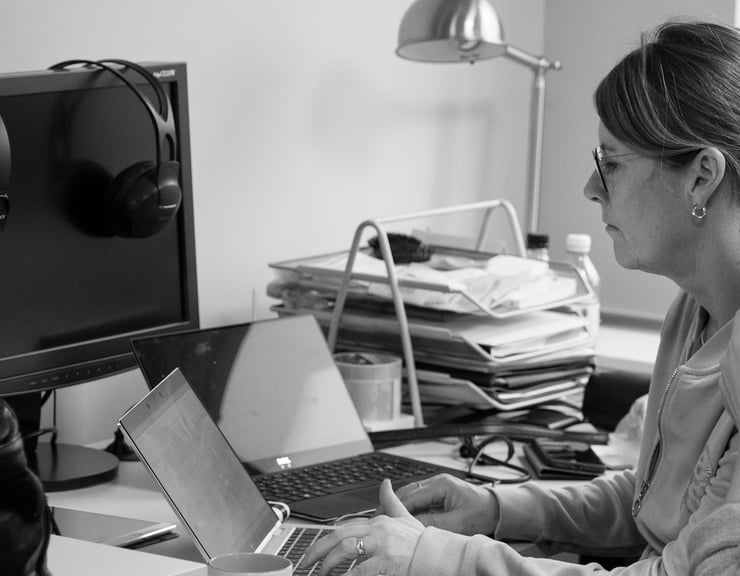
Niyat has been a content manager at Zooma since 2019. She loves to create content and helps to bring campaigns and ideas to life.
Keep me updated!
Subscribe

Video is becoming increasingly important in these extraordinary times. For both internal and external communication, videos currently provide more proximity to customers or employees, more vividness and personal interaction. The areas of use for videos are diverse. In this article, you will learn how to master remote video recording with minimal effort.
According to the Wyzowl survey 'State of Video Marketing 2020', 86% of people want more videos in 2020. However, according to the Content Marketing Institute's 'B2B Content Marketing Report 2020', 29% of marketers still have to jump on the video bandwagon, even though videos have become more accessible in recent years.
Video helps you to humanise your brand, convey information simply and effectively and create strong emotional bonds with your audience. It is a versatile and engaging content format that is easy to share across multiple platforms. Consumers like it because it is easy to digest, and it is entertaining.
Video is very accessible to anyone with access to the Internet, both for viewing and producing. While there is certainly a trend towards higher quality video on a professional level, anyone can jump on their preferred device and create their own video in a short time.
Before you begin recording, you need to determine the software you want to use. Most video conferencing and calling programs offer options to record videos. Take a look at some of the most popular —such as Zoom or Skype—and test them out. Record a couple of short test clips ahead of your actual recording to determine ease of use and quality to ensure you choose the program that works best for your needs.
In Zooma we mainly use Zoom, except when customers prefer others.
Download the step-by-step guide below, and learn how to use Zoom recording:
We also use Vidyard to record videos. You can create videos and share with customers, colleagues and partners. With Vidyard, you can record yourself, your screen or both at the same time using a Chrome extension. It enables you to stay connected when you can't be in the same place.
Get the guide, and you will learn how to record a video with the Vidyard Chrome extension.
Once you've chosen the right software for you and your company, you need a quiet place with adequate Wi-Fi connection to record the video. Ideally, you'll want a quiet room with a neutral background where you can close the door. Zoom also allows using a virtual background. This feature enables you to display an image or video as your background during a Zoom recording. When using a virtual background, try to sit still and not move your head sideways.
Beginners or small teams should start with simple equipment; you can always upgrade. Make sure that the items you include in your kit are both affordable and easy to use as beginners may not be tech-savvy.
Webcams are great for different video types: explainer videos, webinars, interviews, etc. In addition, laptop cameras don't require a whole team to operate. Most modern laptops and all-in-one computers now come with an integrated decent—sometimes even great—built-in webcam. However, external webcams have more space for lenses and other electronics, so they typically provide better quality and additional features like autofocus.
You need to make sure that you use the light in the right way, whether it be from a window, a simple lamp from your living room, or from a professional video lighting kit. It is important to face the light source (ideally a window) or switch on the ceiling light in the room if there is no window.
But windows can also be tricky. So if you want to turn towards a window, you must at the same time make sure that there is no window behind you. The camera will focus on that window, casting a shadow on your face. The benefit of using natural light is that it's free to use and offer natural-looking lighting while the downside is that it's harder to control than a video lighting kit.
With artificial lighting, you can create any kind of light you need for the purposes of your recordings, and you can do it whenever you need it. The ring lights help to compensate for the poor lighting partially. You can find camera cases with this light ring built-in. The tripod is great if you're filming yourself—you don't have to hold it, and it won't shake.
Choosing a good microphone for recording video is crucial. If the audio in your video is poor quality, viewers will drop off. You've probably got experience with built-in microphones. You'll find them on laptops and phones. They provide an easy way to record audio that's in sync with the picture as well as incorporated in the same file as your video. But, for many reasons, the results may not be up to scratch, and other miking options can work much better.
The audio quality of headset microphones may not match that of a lavalier microphone, and you must be aware of built-in noise-cancelling features that may affect the sound of the microphone. If you want to bump up the quality of your video messages, you can connect an external microphone.
You may have seen lavalier microphones before; clipped to the jackets or shirts. Sometimes called 'lav' mics, they're small and are discreet. They clip onto clothing, and since it's attached, the mic moves with the sound source, delivering a consistent sound level. The advantage of using a lavalier mic is that you can place it much closer to the person that you're recording, which in most cases is an essential prerequisite for capturing clear and quality sound.
I hope these tips will help you to master your next remote video recording.
Get more tips for creating engaging video content online.
Good luck!
